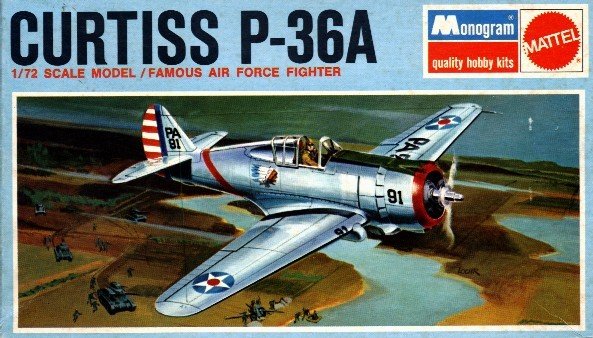
|
KIT # |
6790 |
|
PRICE: |
$ |
|
DECALS: |
One aircraft |
|
REVIEW & |
Rick Crabill |
|
NOTES: |
Classic Plastic from the '60's |

|
HISTORY |
The Curtiss P-36 was the progenitor of the more famous P-40. It served with the USAAF beginning in 1938 and was in front-line use until early 1942. Several P-36s made it into the air against the Japanese at Pearl Harbor with limited success. But it was in foreign hands that the Curtiss Hawk 75, as the export version was known, saw the most extensive combat. It was widely used by the French Air Force and acquitted itself well against the Messershmidt Me.109 in spite of the Hawk’s obsolescence. The Luftwaffe refurbished captured French and Norwegian Hawks and sold them to Finland where they were operated with conspicuous success against the Russians.
The Netherlands purchased the Curtiss machine to equip their forces in the Dutch East Indies. Dutch combat against the Japanese was brief. The Hawk 75/P-36 had by that time been completely outclassed by newer fighters like the Mitsubishi A6M2 Zero. British versions, known as Mohawks, saw service in South Africa and Burma until 1944. China. Thailand, Argentina and Peru also purchased the Hawk 75. Somewhat slower and more lightly armed than its chief opponents, the Curtiss P-36 was nevertheless well liked by all who flew it for its maneuverability and finger-light controls. In British tests the Hawk 75 out flew a Spitfire in dogfights, but lacked the speed and climb to break away from combat at will.
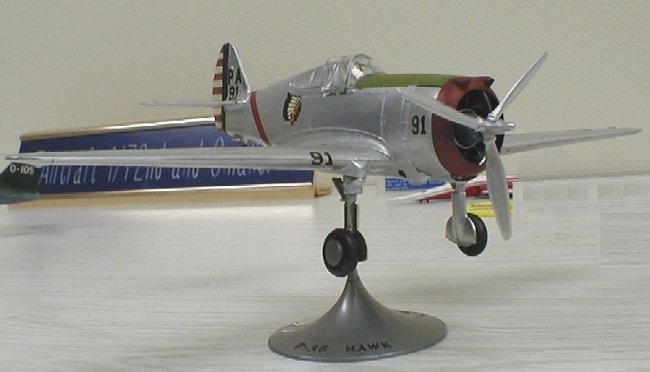
|
THE KIT |
A little gem! Colorful subject matter, restrained panel lines, and beautiful parts fit make this one of the better 1/72nd kits of the 1960’s. Engine detail is good. Monogram kits of the period had nice features such as an included display stand and the painting/finishing instructions were quite detailed. An instrument panel is provided on the decal sheet. A nice feature is the separate cowling ring, which makes painting the red cowling stripe easier for less experienced modelers.
The kit markings represent the 1st Flight leader of the 94th Pursuit Squadron, 1st Pursuit Group, circa 1938. The only serious flaw in this kit is the provision for two guns in each wing, which is incorrect. USAAF aircraft only had two .50 cal nose guns. Exported Hawk 75s did carry both wing and nose guns, however, so this does make more marking schemes available using aftermarket decals. Vichy French schemes are particularly colorful, as were the aircraft flown by Finland. At one time a resin aftermarket kit existed that allowed conversion from the twin-row Pratt & Whitney R-1830 to the nine cylinder R-1820 Wright Cyclone that powered some of the export models.
|
CONSTRUCTION |
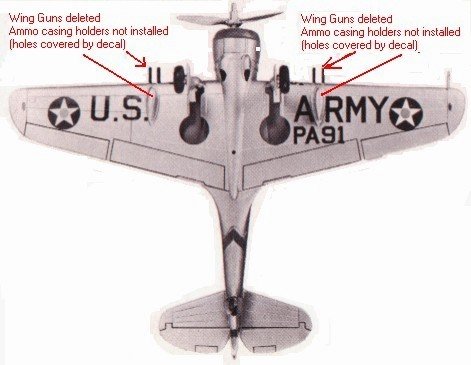 Kit
construction was basically out of the box. Parts fit is excellent and presents
no difficulties to the beginning modeler. The exploded view makes the directions
easy to follow. Step 1 calls for flaring the end of the propeller shaft with
"the heated blade of an old knife" after slipping the shaft through the motor –
ah, the good old days! I chose not to do this so that the propeller can be
removed for shipping.
Kit
construction was basically out of the box. Parts fit is excellent and presents
no difficulties to the beginning modeler. The exploded view makes the directions
easy to follow. Step 1 calls for flaring the end of the propeller shaft with
"the heated blade of an old knife" after slipping the shaft through the motor –
ah, the good old days! I chose not to do this so that the propeller can be
removed for shipping.
Before the wing assembly was glued to the fuselage, the wing guns were filed down, and an old decal was used to cover the mounting holes for the omitted under wing ammo holders. This was lightly sanded before spraying on the aluminum plate. The rest of the kit was assembled stock.
|
PAINT & MARKINGS |
This is the aircraft of the 1st Flight leader of the 94th Pursuit Squadron, 1st Pursuit Group, during peacetime, and as such would be expected to have a highly polished natural metal finish. Testor’s Model Master 1451 Aluminum Plate lacquer was sprayed overall. After it was dried and buffed Future Floor wax was applied by brush to give a polished surface.
The wheel wells and cockpit interior are AeroMaster acrylic Interior Green A/N611. AeroMaster acrylic faded O.D. A/N613 is used on the anti-glare panel. The fuselage stripe is from an old Mania Ki.27 Nate decal sheet, touched up with Testor’s Insignia Red FS 31136 enamel, which was also used for the cowling band.
 I
painted the R-1830 radial engine using Testor’s A38 Flat Dark Gull Gray and A46
Flat Black. Details such as connector rods were picked out using a silver Gel
pen. (It’s great to have kids in the house – the gel pen was my daughter’s
idea!). Tires, guns, exhaust ports and other details are Testor’s A46 Flat
Black. Except for the Aluminum Paint spray can, all paints are hand brushed.
I
painted the R-1830 radial engine using Testor’s A38 Flat Dark Gull Gray and A46
Flat Black. Details such as connector rods were picked out using a silver Gel
pen. (It’s great to have kids in the house – the gel pen was my daughter’s
idea!). Tires, guns, exhaust ports and other details are Testor’s A46 Flat
Black. Except for the Aluminum Paint spray can, all paints are hand brushed.
|
CONCLUSIONS |
This is an excellent kit, not merely for its nostalgic value. It goes together well and is an easy build for the less experienced modeler. Considering the P-36s extensive service on both sides during WWII, any manner of marking schemes can be applied. I would love to see somebody graft a P-40 resin cockpit set and other goodies onto this beauty. It makes an outstanding addition to any 1/72-scale aircraft collection, and was a lot of fun to build!
|
REFERENCES |
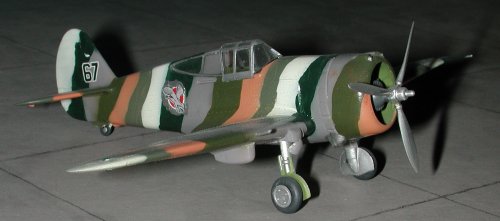 Air
Enthusiast magazine- Nov/Dec ’71, Jan ’72 issues
Air
Enthusiast magazine- Nov/Dec ’71, Jan ’72 issues
American Combat Planes, Ray Wagner, 1968 Doubleday & Company
Additional information can be found on the Internet
Editor's Addendum: Though not as nice as Rick's kit, here are a couple of images of one built about 15 years ago and painted to look like one of the special camouflage trials planes. Yeah, I know that the colors are probably wrong, but that was what was given on the Microscale sheet!
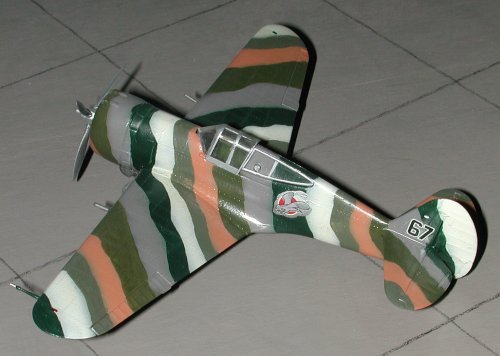 If you would like your product reviewed fairly and quickly by a
site that has thousands of visits a day, please contact
me or see other details in the Note to
Contributors.
If you would like your product reviewed fairly and quickly by a
site that has thousands of visits a day, please contact
me or see other details in the Note to
Contributors.